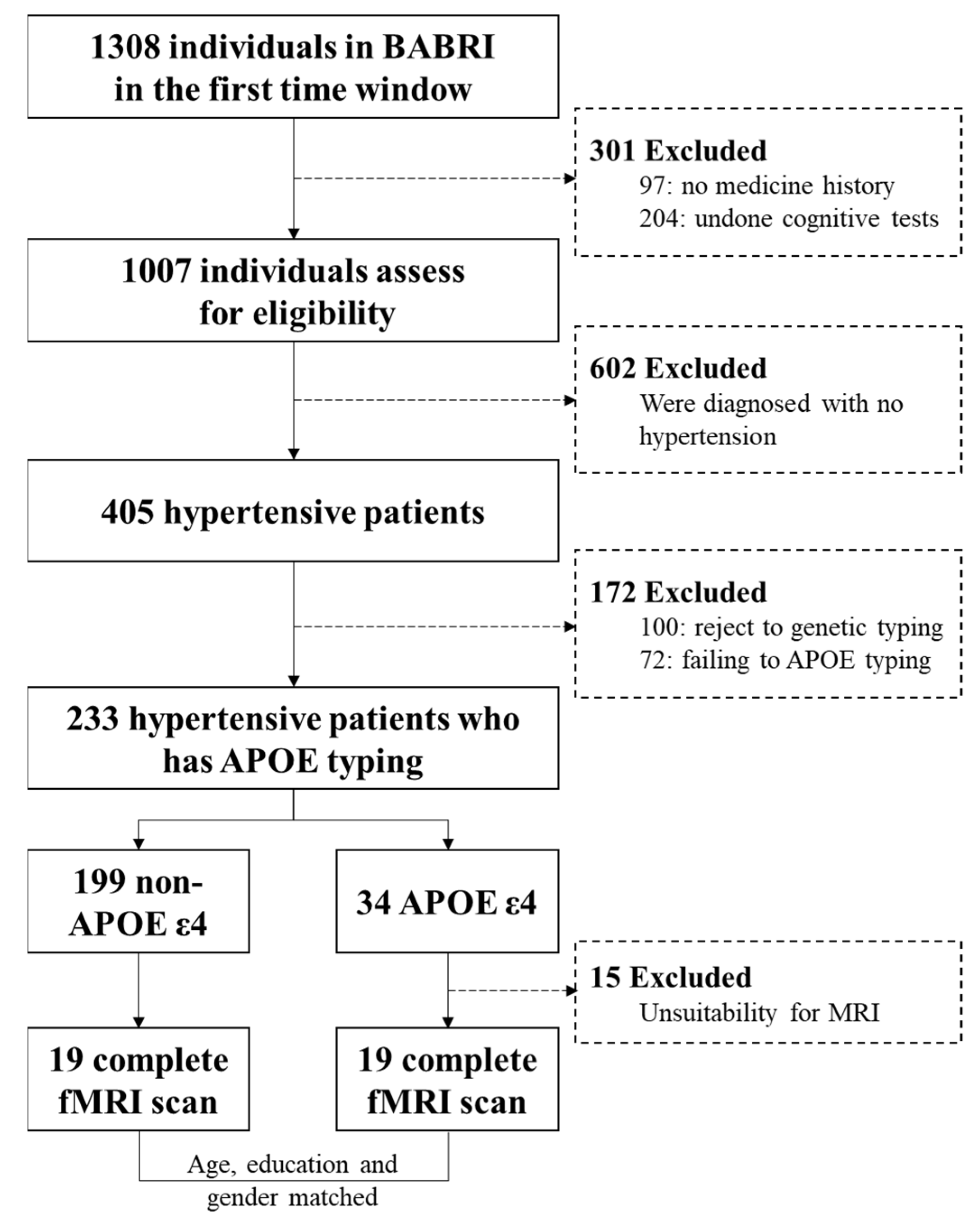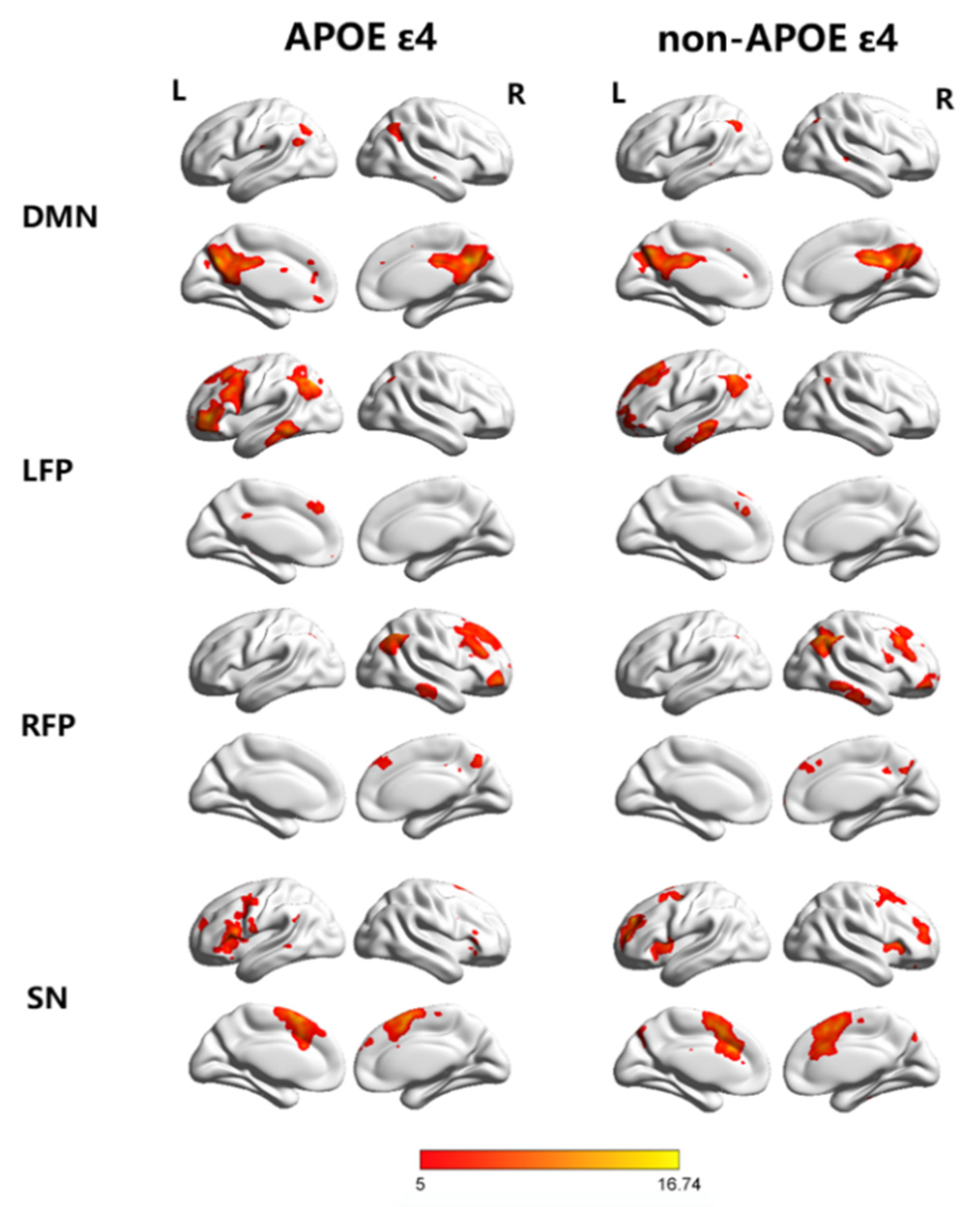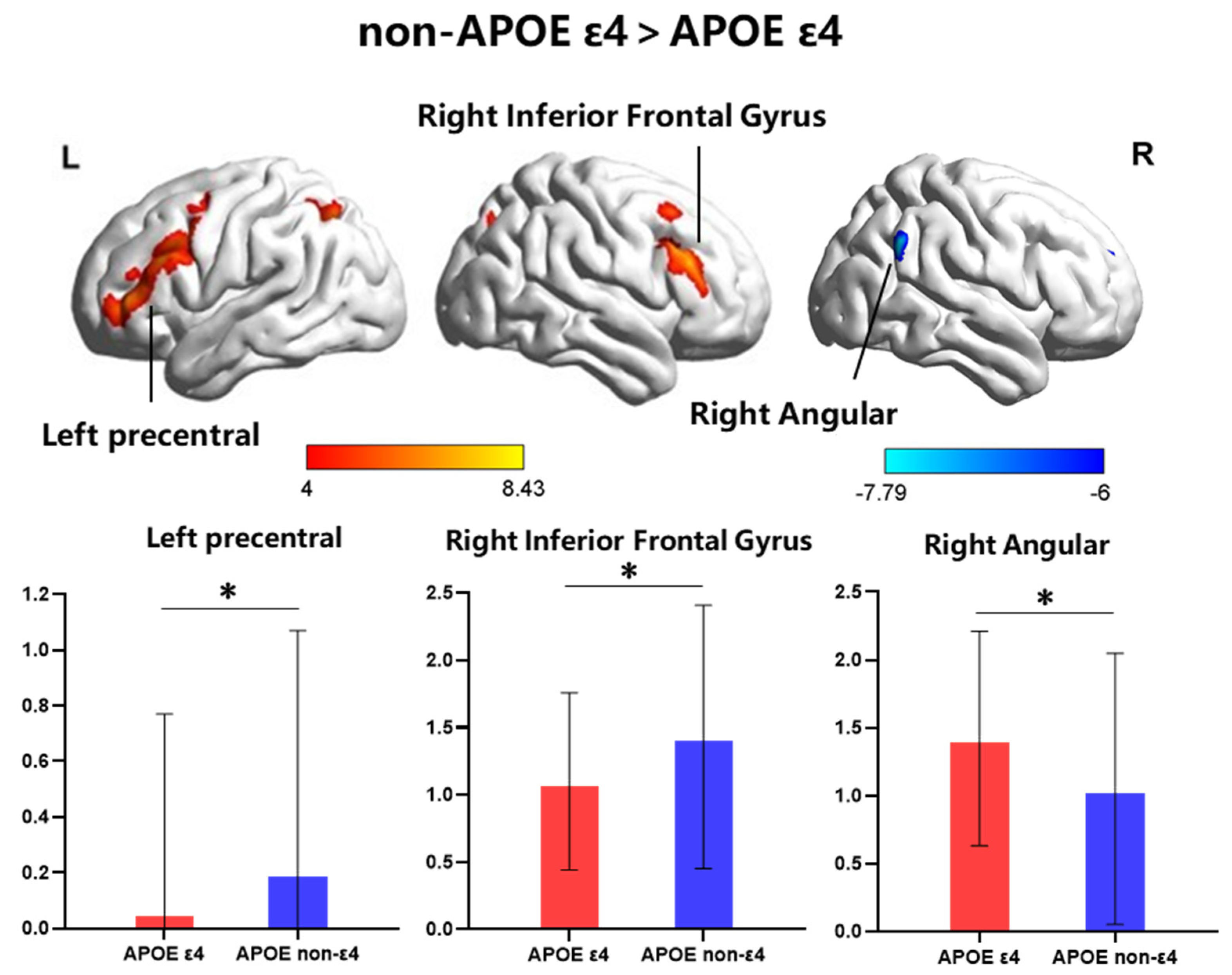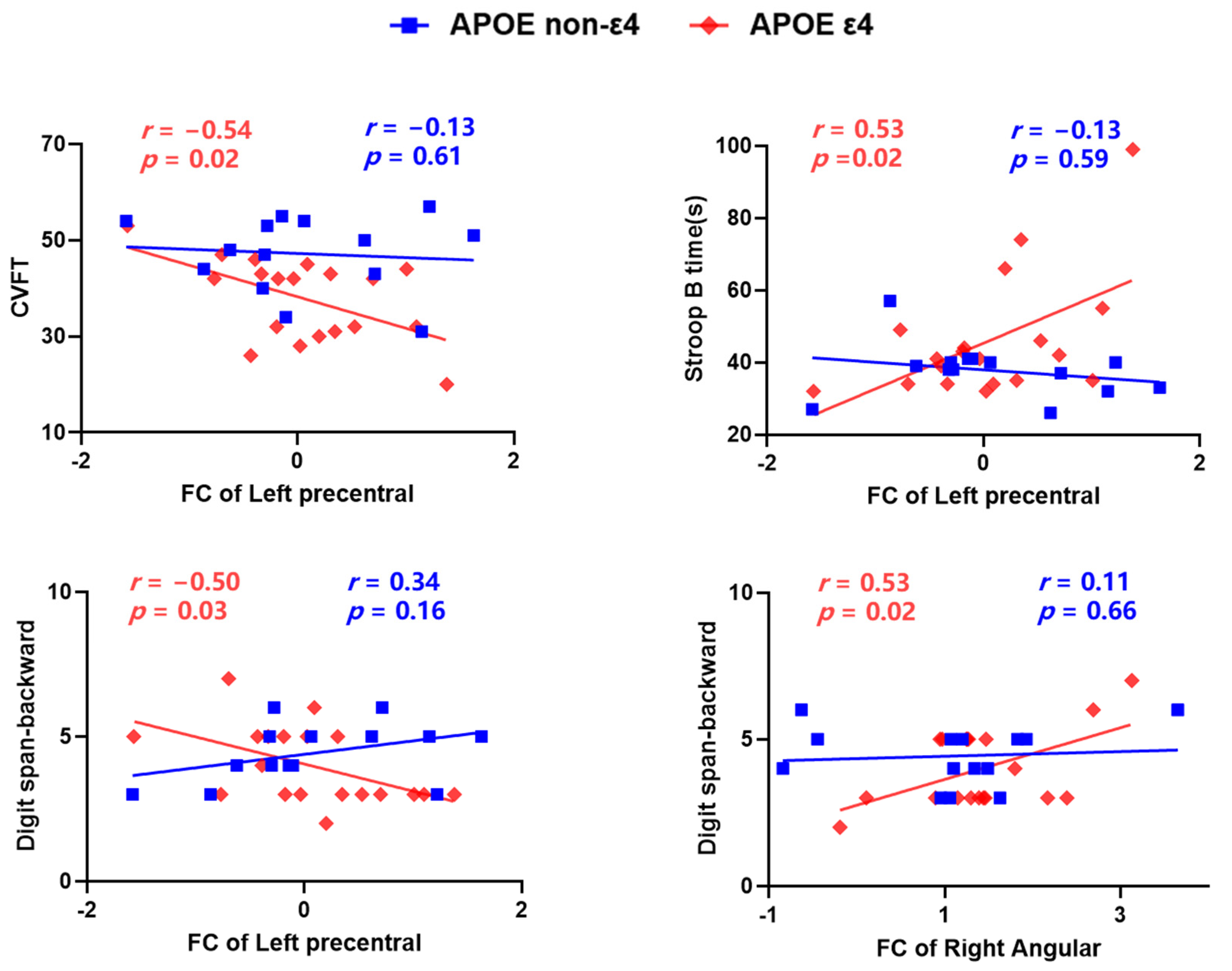The Effect of APOE ɛ4 on the Functional Connectivity in Frontoparietal Network in Hypertensive Patients
Abstract
:1. Introduction
2. Materials and Methods
2.1. Large Sample of Behavioral Research
2.1.1. Participants
2.1.2. Analysis of Genotyping
2.1.3. Neuropsychological Tests and Personal Information Questionnaire
2.2. MRI Studies
2.2.1. Participants
2.2.2. MRI Data Acquisition
2.2.3. Resting-State fMRI Data Analysis
2.3. Statistical Analysis
3. Results
3.1. Neuropsychological Characteristics of the Large Sample
3.2. Selectively Altered RSNs in Patients with Hypertension
3.3. Frontal-Parietal Network Functional Connectivity Is Correlated with Behavior
4. Discussion
5. Conclusions
Author Contributions
Funding
Institutional Review Board Statement
Informed Consent Statement
Data Availability Statement
Acknowledgments
Conflicts of Interest
References
- Sepe-Monti, M.; Pantano, P.; Vanacore, N.; De Carolis, A.; Bianchi, V.; Antonini, G.; Guidoni, S.V.; Giubilei, F. Vascular risk factors and white matter hyperintensities in patients with amnestic mild cognitive impairment. Acta Neurol. Scand. 2007, 115, 419–424. [Google Scholar] [CrossRef] [PubMed]
- Wiseman, R.M.; Saxby, B.K.; Burton, E.J.; Barber, R.; Ford, G.A.; O’Brien, J.T. Hippocampal atrophy, whole brain volume, and white matter lesions in older hypertensive subjects. Neurology 2004, 63, 1892–1897. [Google Scholar] [CrossRef] [PubMed]
- Corder, E.H.; Saunders, A.M.; Strittmatter, W.J.; Schmechel, D.E.; Gaskell, P.C.; Small, G.W.; Roses, A.D.; Haines, J.L.; Pericak-Vance, M.A. Gene dose of apolipoprotein E type 4 allele and the risk of Alzheimer’s disease in late onset families. Science 1993, 261, 921–923. [Google Scholar] [CrossRef] [PubMed]
- Henderson, A.S.; Easteal, S.; Jorm, A.F.; Mackinnon, A.J.; Korten, A.E.; Christensen, H.; Croft, L.; Jacomb, P.A. Apolipoprotein E allele epsilon 4, dementia, and cognitive decline in a population sample. Lancet 1995, 346, 1387–1390. [Google Scholar] [CrossRef]
- Niu, W.; Qi, Y.; Qian, Y.; Gao, P.; Zhu, D. The relationship between apolipoprotein E epsilon2/epsilon3/epsilon4 polymorphisms and hypertension: A meta-analysis of six studies comprising 1812 cases and 1762 controls. Hypertens. Res. 2009, 32, 1060–1066. [Google Scholar] [CrossRef] [PubMed] [Green Version]
- Mesulam, M.M. From sensation to cognition. Brain 1998, 121, 1013–1052. [Google Scholar] [CrossRef]
- Buckholtz, J.W.; Meyer-Lindenberg, A. Psychopathology and the Human Connectome: Toward a Transdiagnostic Model of Risk For Mental Illness. Neuron 2012, 74, 990–1004. [Google Scholar] [CrossRef] [Green Version]
- Pierce, T.W.; Madden, D.J.; Siegel, W.C.; Blumenthal, J.A. Effects of aerobic exercise on cognitive and psychosocial functioning in patients with mild hypertension. Health Psychol. 1993, 12, 286–291. [Google Scholar] [CrossRef]
- Foo, H.; Mather, K.A.; Jiang, J.; Thalamuthu, A.; Wen, W.; Sachdev, P.S. Genetic influence on ageing-related changes in resting-state brain functional networks in healthy adults: A systematic review. Neurosci. Biobehav. Rev. 2020, 113, 98–110. [Google Scholar] [CrossRef]
- Li, X.; Liang, Y.; Chen, Y.; Zhang, J.; Wei, D.; Chen, K.; Shu, N.; Reiman, E.M.; Zhang, Z. Disrupted Frontoparietal Network Mediates White Matter Structure Dysfunction Associated with Cognitive Decline in Hypertension Patients. J. Neurosci. 2015, 35, 10015–10024. [Google Scholar] [CrossRef] [Green Version]
- Li, X.; Ma, C.; Sun, X.; Zhang, J.; Chen, Y.; Chen, K.; Zhang, Z. Disrupted white matter structure underlies cognitive deficit in hypertensive patients. Eur. Radiol. 2015, 26, 2899–2907. [Google Scholar] [CrossRef] [PubMed]
- Li, X.; Wang, W.; Wang, A.; Li, P.; Zhang, J.; Tao, W.; Zhang, Z. Vulnerability of the frontal and parietal regions in hypertensive patients during working memory task. J. Hypertens. 2017, 35, 1044–1051. [Google Scholar] [CrossRef] [PubMed]
- Carnevale, L.; Maffei, A.; Landolfi, A.; Grillea, G.; Carnevale, D.; Lembo, G. Brain Functional Magnetic Resonance Imaging Highlights Altered Connections and Functional Networks in Patients With Hypertension. Hypertension 2020, 76, 1480–1490. [Google Scholar] [CrossRef]
- Wu, X.; Li, Q.; Yu, X.; Chen, K.; Fleisher, A.S.; Guo, X.; Zhang, J.; Reiman, E.M.; Yao, L.; Li, R. A Triple Network Connectivity Study of Large-Scale Brain Systems in Cognitively Normal APOE4 Carriers. Front. Aging Neurosci. 2016, 8, 231. [Google Scholar] [CrossRef] [PubMed] [Green Version]
- Ying, L.; Li, Z.; Jing, W.; Li, C.; Zhang, X.; Alzheimer’s Disease Neuroimaging Initiative. Frequency Specific Effects of ApoE ε4 Allele on Resting-State Networks in Nonde-mented Elders. BioMed Res. Int. 2017, 2017, 9823501. [Google Scholar]
- Lu, H.; Ma, S.L.; Wong, S.W.; Tam, C.W.; Cheng, S.T.; Chan, S.S.; Lam, L.C.W. Aberrant interhemispheric functional connectivity within default mode network and its relationships with neurocognitive features in cognitively normal APOE epsilon 4 elderly carriers. Int. Psychogeriatr. 2017, 29, 805–814. [Google Scholar] [CrossRef]
- Machulda, M.M.; Jones, D.T.; Vemuri, P.; McDade, E.; Avula, R.; Przybelski, S.; Boeve, B.F.; Knopman, D.S.; Petersen, R.C.; Jack, C. Effect of APOE ε4 Status on Intrinsic Network Connectivity in Cognitively Normal Elderly Subjects. Arch. Neurol. 2011, 68, 1131–1136. [Google Scholar] [CrossRef] [Green Version]
- Van den Heuvel, M.P.; Mandl, R.C.; Kahn, R.S.; Hulshoff Pol, H.E. Functionally linked resting-state networks reflect the underlying structural connectivity architecture of the human brain. Hum. Brain Mapp. 2009, 30, 3127–3141. [Google Scholar] [CrossRef]
- Wang, R.; Fratiglioni, L.; Laukka, E.J.; Lövdén, M.; Kalpouzos, G.; Keller, L.; Graff, C.; Salami, A.; Bäckman, L.; Qiu, C. Effects of vascular risk factors and APOE ε4 on white matter integrity and cognitive decline. Neurology 2015, 84, 1128–1135. [Google Scholar] [CrossRef] [Green Version]
- De Leeuw, F.-E.; Richard, F.; de Groot, J.C.; van Duijn, C.M.; Hofman, A.; van Gijn, J.; Breteler, M.M.B. Interaction between hypertension, apoE, and cerebral white matter lesions. Stroke 2004, 35, 1057–1060. [Google Scholar] [CrossRef] [Green Version]
- Yang, C.; Li, X.; Zhang, J.; Chen, Y.; Li, H.; Wei, D.; Lu, P.; Liang, Y.; Liu, Z.; Shu, N.; et al. Early prevention of cognitive impairment in the community population: The Beijing Aging Brain Rejuvenation Initiative. Alzheimer’s Dement. 2021, 17, 1610–1618. [Google Scholar] [CrossRef] [PubMed]
- Chen, Y.; Lv, C.; Li, X.; Zhang, J.; Chen, K.; Liu, Z.; Li, H.; Fan, J.; Qin, T.; Luo, L.; et al. The positive impacts of early-life education on cognition, leisure activity, and brain structure in healthy aging. Aging 2019, 11, 4923–4942. [Google Scholar] [CrossRef] [PubMed]
- Felsky, D.; Voineskos, A.N.; Lerch, J.P.; Nazeri, A.; Shaikh, S.A.; Rajji, T.K.; Mulsant, B.H.; Kennedy, J.L. Myelin-Associated Glycoprotein Gene and Brain Morphometry in Schizophrenia. Front. Psychiatry 2012, 3, 40. [Google Scholar] [CrossRef] [PubMed] [Green Version]
- Calhoun, V.; Adali, T.; Pearlson, G.; Pekar, J. A method for making group inferences from functional MRI data using independent component analysis. Hum. Brain Mapp. 2001, 14, 140–151. [Google Scholar] [CrossRef]
- Andrews, S.; Das, D.; Anstey, K.J.; Easteal, S. Interactive Effect of APOE Genotype and Blood Pressure on Cognitive Decline: The PATH through Life Study. J. Alzheimer’s Dis. 2015, 44, 1087–1098. [Google Scholar] [CrossRef]
- Peila, R.; White, L.R.; Petrovich, H.; Masaki, K.; Ross, G.W.; Havlik, R.J.; Launer, L.J. Joint effect of the APOE gene and midlife systolic blood pressure on late-life cognitive impairment: The Honolulu-Asia aging study. Stroke 2001, 32, 2882–2889. [Google Scholar] [CrossRef] [Green Version]
- Leech, R.; Kamourieh, S.; Beckmann, C.F.; Sharp, D.J. Fractionating the Default Mode Network: Distinct Contributions of the Ventral and Dorsal Posterior Cingulate Cortex to Cognitive Control. J. Neurosci. 2011, 31, 3217–3224. [Google Scholar] [CrossRef]
- Elgh, E.; Larsson, A.; Eriksson, S.; Nyberg, L. Altered Prefrontal Brain Activity in Persons at Risk for Alzheimer’s Disease: An fMRI Study. Int. Psychogeriatr. 2003, 15, 121–133. [Google Scholar] [CrossRef]
- Johanna, L.; Jonas, P.; Martin, I.; Anne, L.; Marc, C.; Christine, V.B.; Adolfsson, R.; Bäckman, L.; Nilsson, L.; Petersson, K.M.; et al. Reduced functional brain activity response in cognitively intact apolipoprotein E ε4 carriers. Brain 2006, 129, 1240–1248. [Google Scholar]
- Drzezga, A.; Grimmer, T.; Henriksen, G.; Muhlau, M.; Perneczky, R.; Miederer, I.; Praus, C.; Sorg, C.; Wohlschlager, A.; Riemenschneider, M.; et al. Effect of APOE genotype on amyloid plaque load and gray matter volume in Alzheimer disease. Neurology 2009, 72, 1487–1494. [Google Scholar] [CrossRef]
- Wang, L.; Goldstein, F.; Veledar, E.; Levey, A.; Lah, J.; Meltzer, C.; Holder, C.; Mao, H. Alterations in Cortical Thickness and White Matter Integrity in Mild Cognitive Impairment Measured by Whole-Brain Cortical Thickness Mapping and Diffusion Tensor Imaging. Am. J. Neuroradiol. 2009, 30, 893–899. [Google Scholar] [CrossRef] [PubMed] [Green Version]
- Fennema-Notestine, C.; Panizzon, M.S.; Thompson, W.R.; Chen, C.-H.; Eyler, L.T.; Fischl, B.; Franz, C.E.; Grant, M.D.; Jak, A.J.; Jernigan, T.L.; et al. Presence of ApoE ε4 Allele Associated with Thinner Frontal Cortex in Middle Age. J. Alzheimer’s Dis. 2011, 26, 49–60. [Google Scholar] [CrossRef] [PubMed] [Green Version]
- McLaren, D.G.; Sreenivasan, A.; Diamond, E.L.; Mitchell, M.B.; Van Dijk, K.R.; DeLuca, A.N.; O’Brien, J.L.; Rentz, D.M.; Sperling, R.A.; Atri, A. Tracking Cognitive Change over 24 Weeks with Longitudinal Functional Magnetic Resonance Imaging in Alzheimer’s Disease. Neurodegener. Dis. 2012, 9, 176–186. [Google Scholar] [CrossRef] [PubMed] [Green Version]
- De Chastelaine, M.; Wang, T.H.; Minton, B.; Muftuler, L.T.; Rugg, M.D. The Effects of Age, Memory Performance, and Callosal Integrity on the Neural Correlates of Successful Associative Encoding. Cereb. Cortex 2011, 21, 2166–2176. [Google Scholar] [CrossRef]
- Heinzel, S.; Metzger, F.G.; Ehlis, A.-C.; Korell, R.; Alboji, A.; Haeussinger, F.B.; Hagen, K.; Maetzler, W.; Eschweiler, G.W.; Berg, D.; et al. Aging-related cortical reorganization of verbal fluency processing: A functional near-infrared spectroscopy study. Neurobiol. Aging 2013, 34, 439–450. [Google Scholar] [CrossRef]
- Katzorke, A.; Zeller, J.B.M.; Müller, L.D.; Lauer, M.; Polak, T.; Reif, A.; Deckert, J.; Herrmann, M.J. Reduced Activity in the Right Inferior Frontal Gyrus in Elderly APOE-E4 Carriers during a Verbal Fluency Task. Front. Hum. Neurosci. 2017, 11, 46. [Google Scholar] [CrossRef] [Green Version]
- Herrmann, M.J.; Langer, J.B.; Jacob, C.; Ehlis, A.-C.; Fallgatter, A.J. Reduced Prefrontal Oxygenation in Alzheimer Disease During Verbal Fluency Tasks. Am. J. Geriatr. Psychiatry 2008, 16, 125–135. [Google Scholar] [CrossRef]
- Vincent, J.L.; Kahn, I.; Snyder, A.Z.; Raichle, M.E.; Buckner, R.L. Evidence for a Frontoparietal Control System Revealed by Intrinsic Functional Connectivity. J. Neurophysiol. 2008, 100, 3328–3342. [Google Scholar] [CrossRef] [Green Version]
- Cabeza, R.; Ciaramelli, E.; Olson, I.R.; Moscovitch, M. The parietal cortex and episodic memory: An attentional account. Nat. Rev. Neurosci. 2008, 9, 613–625. [Google Scholar] [CrossRef] [Green Version]
- Oitzl, M.S.; Champagne, D.L.; Veen, R.; Kloet, E. Brain development under stress: Hypotheses of glucocorticoid actions revisited. Neurosci. Biobehav. Rev. 2010, 34, 853–866. [Google Scholar] [CrossRef]
- Levi, O.; Jongen-Relo, A.L.; Feldon, J.; Michaelson, D.M. Brain area- and isoform-specific inhibition of synaptic plasticity by apoE4. J. Neurol. Sci. 2005, 229–230, 241–248. [Google Scholar] [CrossRef] [PubMed]
- Blain, J.-F.; Sullivan, P.M.; Poirier, J. A deficit in astroglial organization causes the impaired reactive sprouting in human apolipoprotein E4 targeted replacement mice. Neurobiol. Dis. 2006, 21, 505–514. [Google Scholar] [CrossRef]
- Bennet, A.M.; di Angelantonio, E.; Ye, Z.; Wensley, F.; Dahlin, A.; Ahlbom, A.; Keavney, B.; Collins, R.; Wiman, B.; de Faire, U.; et al. Association of apolipoprotein E genotypes with lipid levels and coronary risk. JAMA 2007, 298, 1300–1311. [Google Scholar] [CrossRef]
- Kester, M.I.; van der Flier, W.M.; Mandic, G.; Blankenstein, M.A.; Scheltens, P.; Muller, M. Joint Effect of Hypertension and APOE Gen-otype on CSF Biomarkers for Alzheimer’s Disease. J. Alzheimers Dis. 2010, 20, 1083–1090. [Google Scholar] [CrossRef] [PubMed]
- Jennings, J.R.; Muldoon, M.F.; Price, J.; Christie, I.C.; Meltzer, C.C. Cerebrovascular support for cognitive processing in hypertensive patients is altered by blood pressure treatment. Hypertension 2008, 52, 65–71. [Google Scholar] [CrossRef] [PubMed]
- Jennings, J.R.; Muldoon, M.F.; Allen, B.; Ginty, A.T.; Gianaros, P.J. Cerebrovascular function in hypertension: Does high blood pressure make you old? Psychophysiology 2020, 58, e136542020. [Google Scholar] [CrossRef] [PubMed]




| APOE ε4 (n = 34) | Non-APOE ε4 (n = 199) | F | p | |
|---|---|---|---|---|
| AGE (years) | 66.12 ± 6.848 | 65.23 ± 7.265 | 0.66 | 0.509 |
| SEX (male, %) | 12, 35.3% | 70, 35.2% | 0.00 | 0.566 |
| Education (years) | 10.74 ± 3.387 | 11.11 ± 3.619 | −0.57 | 0.570 |
| MMSE | 27.53 ± 1.674 | 27.87 ± 1.577 | 0.965 | 0.327 |
| Memory | ||||
| AVLT | 5.09 ± 2.598 | 5.77 ± 2.490 | 1.69 | 0.195 |
| ROCF-delay | 13.71 ± 5.745 | 13.85 ± 6.375 | 0.03 | 0.856 |
| Digit span-forward | 6.85 ± 1.329 | 7.39 ± 1.221 | 4.59 | 0.033 |
| Digit span-backward | 4.06 ± 1.349 | 4.37 ± 0.955 | 0.303 | 0.586 |
| Executive function | ||||
| Stroop C-B time (s) | 41.56 ± 14.724 | 37.04 ± 11.081 | 3.95 | 0.048 |
| TMT B time (s) | 184.09 ± 60.452 | 163.96 ± 46.934 | 4.11 | 0.044 |
| Processing speed | ||||
| TMT A time (s) | 62.26 ± 20.211 | 57.91 ± 20.236 | 0.69 | 0.407 |
| Stroop B time (s) | 38.74 ± 9.291 | 37.61 ± 7.815 | 0.36 | 0.547 |
| Visuo-spatial ability | ||||
| ROCF-copy | 33.18 ± 2.564 | 33.20 ± 3.378 | 0.01 | 0.907 |
| CDT | 24.36 ± 3.141 | 24.61 ± 3.490 | 0.02 | 0.882 |
| Language | ||||
| CVFT | 42.53 ± 8.140 | 45.83 ± 8.580 | 4.67 | 0.032 |
| BNT | 22.82 ± 4.196 | 23.41 ± 3.454 | 0.35 | 0.556 |
| APOE ε4 (n = 19) | Non-APOE ε4 (n = 19) | F | p | |
|---|---|---|---|---|
| AGE (years) | 68.26 ± 6.94 | 68.16 ± 4.07 | −0.06 | 0.96 |
| SEX (male, %) | 11, 47.4% | 9, 57.9% | 0.11 | 0.745 |
| EDU (years) | 10.13 ± 3.01 | 11.74 ± 3.48 | 1.52 | 0.14 |
| MMSE | 26.58 ± 4.22 | 27.89 ± 1.66 | 1.42 | 0.24 |
| Memory | ||||
| AVLT | 4.53 ± 3.29 | 5.21 ± 2.12 | 0.08 | 0.78 |
| ROCF-delay | 12.26 ± 6.23 | 14.11 ± 5.91 | 0.83 | 0.37 |
| Digit span-forward | 6.89 ± 1.33 | 8.26 ± 1.76 | 5.42 | 0.026 |
| Digit span-backward | 4.00 ± 1.33 | 4.37 ± 0.96 | 0.43 | 0.52 |
| Executive function | ||||
| Stroop C-B time (s) | 43.26 ± 13.78 | 31.94 ± 13.41 | 5.02 | 0.033 |
| TMT B time (s) | 204.28 ± 62.48 | 167.42 ± 55.74 | 3.06 | 0.09 |
| Processing speed | ||||
| TMT A time (s) | 70.05 ± 33.30 | 59.53 ± 15.94 | 1.16 | 0.29 |
| Stroop B time (s) | 46.05 ± 17.12 | 38.74 ± 6.72 | 2.42 | 0.13 |
| Visuo-spatial ability | ||||
| ROCF-copy | 31.84 ± 3.75 | 34.21 ± 1.99 | 4.37 | 0.044 |
| CDT | 23.32 ± 4.74 | 24.63 ± 3.62 | 0.57 | 0.46 |
| Language | ||||
| CVFT | 37.89 ± 8.69 | 45.32 ± 8.33 | 4.97 | 0.033 |
| BNT | 21.95 ± 4.31 | 23.58 ± 3.42 | 3.58 | 0.07 |
Publisher’s Note: MDPI stays neutral with regard to jurisdictional claims in published maps and institutional affiliations. |
© 2022 by the authors. Licensee MDPI, Basel, Switzerland. This article is an open access article distributed under the terms and conditions of the Creative Commons Attribution (CC BY) license (https://creativecommons.org/licenses/by/4.0/).
Share and Cite
Wang, D.; Xu, C.; Wang, W.; Lu, H.; Zhang, J.; Liang, F.; Li, X. The Effect of APOE ɛ4 on the Functional Connectivity in Frontoparietal Network in Hypertensive Patients. Brain Sci. 2022, 12, 515. https://doi.org/10.3390/brainsci12050515
Wang D, Xu C, Wang W, Lu H, Zhang J, Liang F, Li X. The Effect of APOE ɛ4 on the Functional Connectivity in Frontoparietal Network in Hypertensive Patients. Brain Sciences. 2022; 12(5):515. https://doi.org/10.3390/brainsci12050515
Chicago/Turabian StyleWang, Dandan, Chang Xu, Wenxiao Wang, Hui Lu, Junying Zhang, Furu Liang, and Xin Li. 2022. "The Effect of APOE ɛ4 on the Functional Connectivity in Frontoparietal Network in Hypertensive Patients" Brain Sciences 12, no. 5: 515. https://doi.org/10.3390/brainsci12050515
APA StyleWang, D., Xu, C., Wang, W., Lu, H., Zhang, J., Liang, F., & Li, X. (2022). The Effect of APOE ɛ4 on the Functional Connectivity in Frontoparietal Network in Hypertensive Patients. Brain Sciences, 12(5), 515. https://doi.org/10.3390/brainsci12050515






